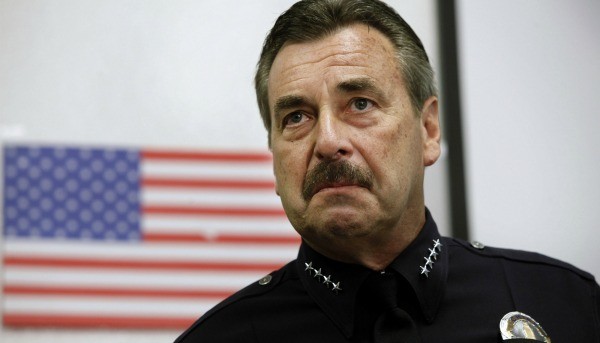LAPD Police Chief, 'A real Tragedy, but we didn't do anything wrong': Jury Does Not Believe Officers - $24 million to Latino boy Paralyzed in shooting
 In photo, racist suspect, LAPD Chief Charlie Beck. From [HERE] In what is likely a record judgment, a jury on Friday handed down a $24-million verdict against the Los Angeles Police Department for the shooting of a 13-year-old boy who was playing with a replica gun. His injury left him paralyzed.
In photo, racist suspect, LAPD Chief Charlie Beck. From [HERE] In what is likely a record judgment, a jury on Friday handed down a $24-million verdict against the Los Angeles Police Department for the shooting of a 13-year-old boy who was playing with a replica gun. His injury left him paralyzed.
The case centered on a December 2010 encounter in which Officer Victor Abarca and his partner were on patrol in Glassell Park shortly before 8 p.m., according to police records.
The officers, who told investigators they were in search of graffiti and gang activity, came upon Rohayent Gomez and two of his friends on a street. Gomez's attorney, Renaldo Casillas, said the evidence and testimony from two eyewitnesses to the shooting "completely blew apart" Abarca's account.
Casillas said Gomez was playing "cops and robbers" in the street near his home with his friends. They each had airsoft pistols that fire small plastic pellets and are made to look like actual firearms.
The witnesses told jurors that the officers arrived and immediately drew their weapons, Casillas said. Gomez, who was hiding behind a parked van to reload his pellet gun, was unaware of the police, Casillas said, and was startled when Abarca came around the side of the van.
The witnesses said the officer gave one command ordering Gomez not to move and then fired a single shot at the boy as he took a step out of surprise, Casillas said. The eyewitness testified that the officer shot the teen seconds after the boy came out from behind the van. The boy was hit in the chest and is now paralyzed.
That account differs dramatically from the one Abarca gave investigators. Abarca said that in the darkness he was unaware he was confronting a teenager and claimed that the boy ignored repeated commands to come out from behind the van.
When he finally complied, Abarca said, the person "had both hands concealed within his sweatshirt and was bent slightly at the waist," according to the LAPD's internal investigation into the incident.
Abarca said it was only then that he drew his service pistol and fired a single round when Gomez pulled what appeared to be a pistol from his waistband.
Abarca told investigators he had not been able to see the colored tip of the airsoft pistol that is supposed to distinguish it as a fake.
Casillas rejected that assertion, saying the witnesses had testified that it was "glaringly apparent they were kids and that they were playing cops and robbers."
The boy's wounds also countered the officer's version of events, Casillas said. Gomez was shot in the left clavicle and the bullet traveled downward into his spine — a trajectory that would have been impossible if Gomez had squared off with Abarca as the officer claimed, Casillas said.
The jury found that Abarca had used excessive force and was negligent in his decision to fire. City taxpayers will pay the $24-million verdict, and Abarca himself could be ordered to pay additional punitive damages if the jury chooses to award them at a later hearing.
LAPD Chief Charlie Beck called the shooting a "tragedy." He said in a statement that he's been seeking legislation that would require makers of replica guns to better distinguish them from regular guns.
"This is a tragedy for all involved, but in particular for the young man injured in this police shooting and for the officer who believed that he was protecting himself and his partner from a real threat," Beck said. "The replica gun [the boy] had was indistinguishable from a real handgun on a dark night. When our officers are confronted with a realistic replica weapon in the field, they have to react in a split second to the perceived threat. If our officers delay or don't respond to armed suspects, it could cost them their lives."
Last year, Abarca was cleared of any wrongdoing by the Police Commission, which rules in all shooting cases on whether officers were justified in using deadly force.
The commission concluded that the replica "was indistinguishable from a real firearm" and that "reasonably, any officer in similar circumstances would be focused on the threat posed by the weapon and would not see the red tip on the end of the gun."